A Systematic Review: Prevalence and Causes of Medication Errors
VerifiedAdded on 2023/06/07
|13
|2827
|433
Report
AI Summary
This report presents a systematic review analyzing the causes of medication errors by nursing professionals in hospital settings. It identifies key factors such as lack of communication skills, inadequate training, and increased nursing workload as primary contributors to medication administration and dosage errors. The review synthesizes evidence from multiple research articles, highlighting the impact of medication errors on patient mortality, hospital stay length, and healthcare costs. The study concludes with objectives for future research, including the effect of enhanced training and nursing education on reducing medication errors, increasing nursing staff to decrease nurse-patient ratios, and overall reduction in nursing stress. The report emphasizes the need for improved communication, better training programs, and adequate staffing to mitigate medication errors and enhance patient safety.
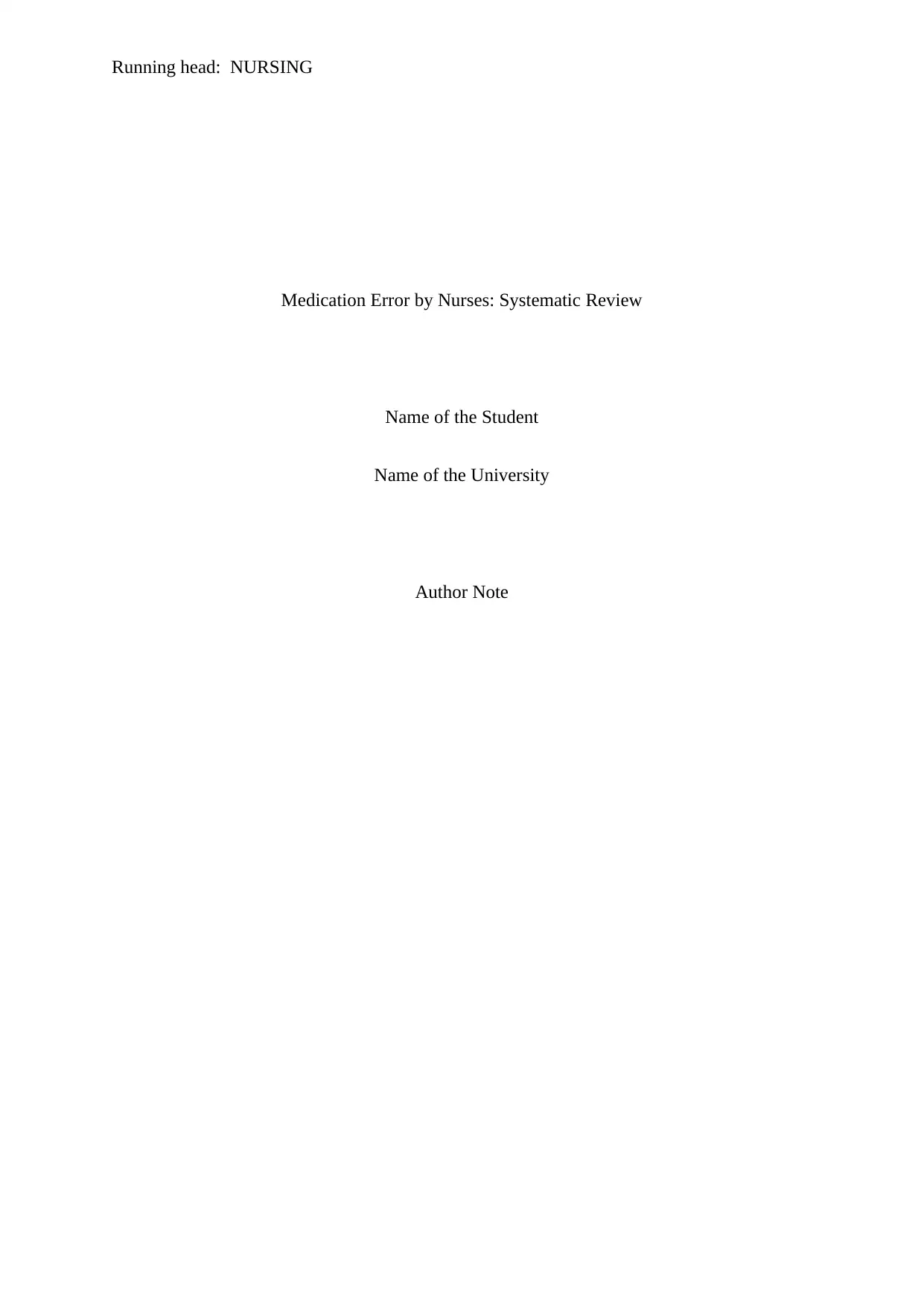
Running head: NURSING
Medication Error by Nurses: Systematic Review
Name of the Student
Name of the University
Author Note
Medication Error by Nurses: Systematic Review
Name of the Student
Name of the University
Author Note
Paraphrase This Document
Need a fresh take? Get an instant paraphrase of this document with our AI Paraphraser
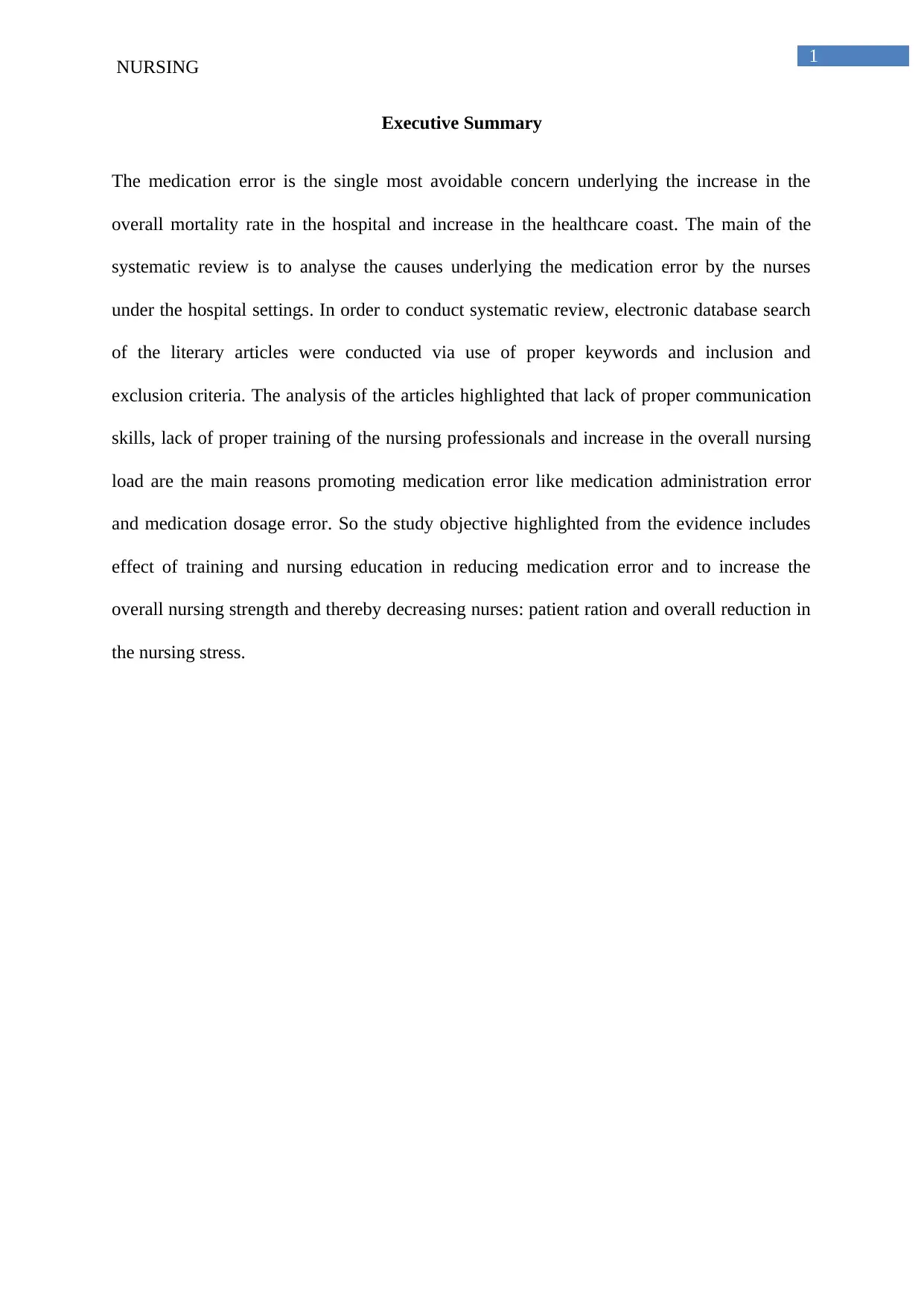
1
NURSING
Executive Summary
The medication error is the single most avoidable concern underlying the increase in the
overall mortality rate in the hospital and increase in the healthcare coast. The main of the
systematic review is to analyse the causes underlying the medication error by the nurses
under the hospital settings. In order to conduct systematic review, electronic database search
of the literary articles were conducted via use of proper keywords and inclusion and
exclusion criteria. The analysis of the articles highlighted that lack of proper communication
skills, lack of proper training of the nursing professionals and increase in the overall nursing
load are the main reasons promoting medication error like medication administration error
and medication dosage error. So the study objective highlighted from the evidence includes
effect of training and nursing education in reducing medication error and to increase the
overall nursing strength and thereby decreasing nurses: patient ration and overall reduction in
the nursing stress.
NURSING
Executive Summary
The medication error is the single most avoidable concern underlying the increase in the
overall mortality rate in the hospital and increase in the healthcare coast. The main of the
systematic review is to analyse the causes underlying the medication error by the nurses
under the hospital settings. In order to conduct systematic review, electronic database search
of the literary articles were conducted via use of proper keywords and inclusion and
exclusion criteria. The analysis of the articles highlighted that lack of proper communication
skills, lack of proper training of the nursing professionals and increase in the overall nursing
load are the main reasons promoting medication error like medication administration error
and medication dosage error. So the study objective highlighted from the evidence includes
effect of training and nursing education in reducing medication error and to increase the
overall nursing strength and thereby decreasing nurses: patient ration and overall reduction in
the nursing stress.
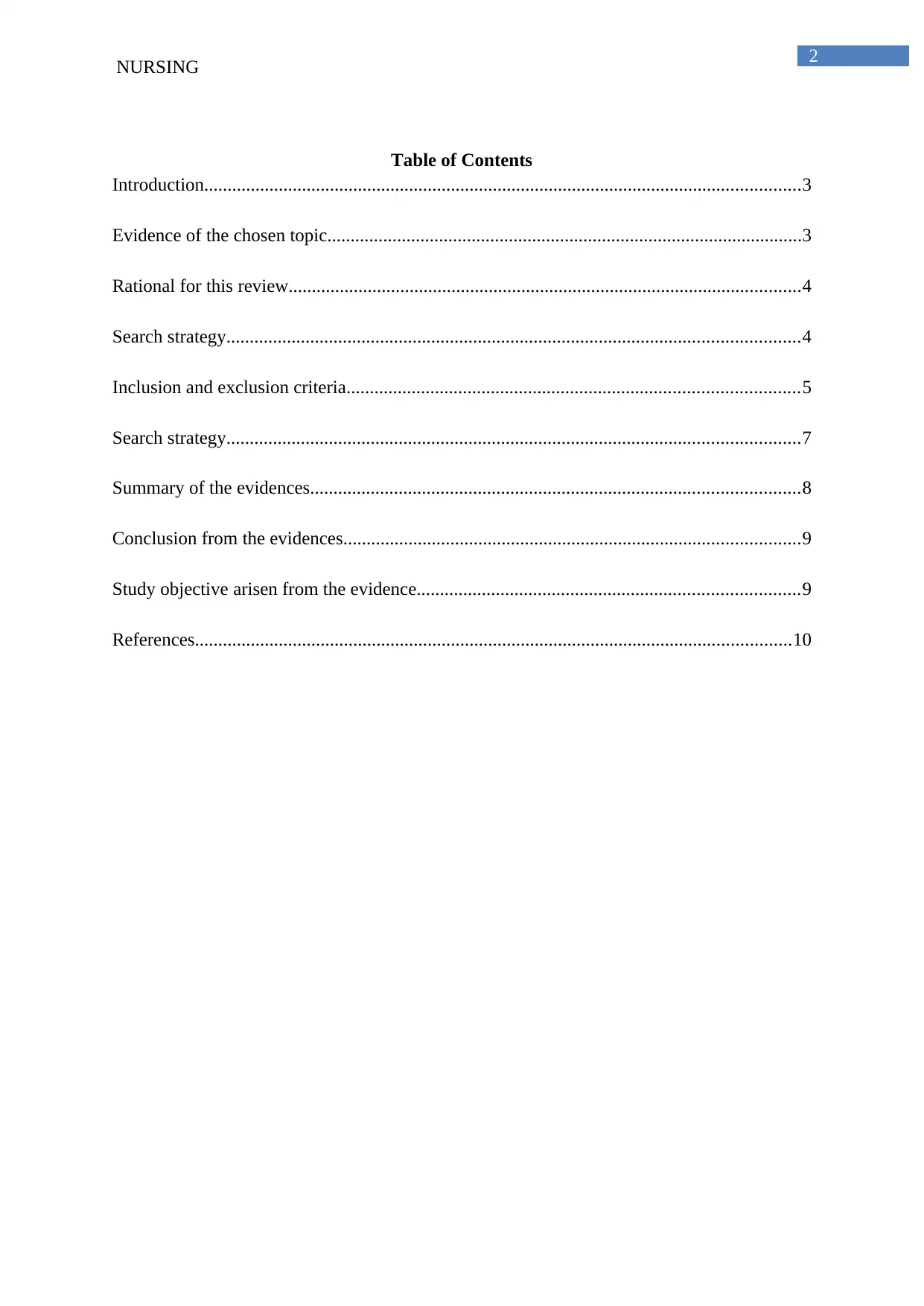
2
NURSING
Table of Contents
Introduction................................................................................................................................3
Evidence of the chosen topic......................................................................................................3
Rational for this review..............................................................................................................4
Search strategy...........................................................................................................................4
Inclusion and exclusion criteria.................................................................................................5
Search strategy...........................................................................................................................7
Summary of the evidences.........................................................................................................8
Conclusion from the evidences..................................................................................................9
Study objective arisen from the evidence..................................................................................9
References................................................................................................................................10
NURSING
Table of Contents
Introduction................................................................................................................................3
Evidence of the chosen topic......................................................................................................3
Rational for this review..............................................................................................................4
Search strategy...........................................................................................................................4
Inclusion and exclusion criteria.................................................................................................5
Search strategy...........................................................................................................................7
Summary of the evidences.........................................................................................................8
Conclusion from the evidences..................................................................................................9
Study objective arisen from the evidence..................................................................................9
References................................................................................................................................10
⊘ This is a preview!⊘
Do you want full access?
Subscribe today to unlock all pages.

Trusted by 1+ million students worldwide
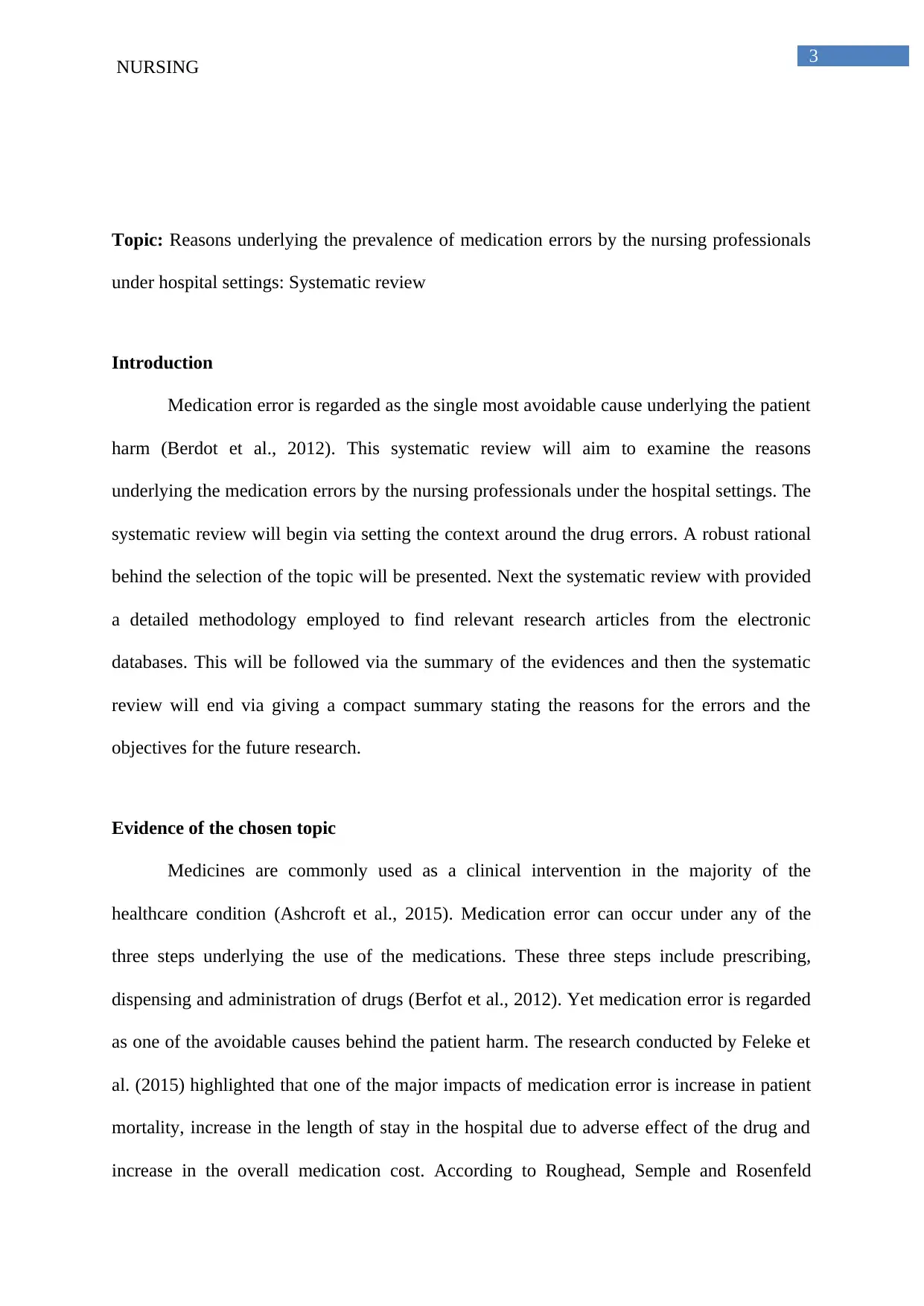
3
NURSING
Topic: Reasons underlying the prevalence of medication errors by the nursing professionals
under hospital settings: Systematic review
Introduction
Medication error is regarded as the single most avoidable cause underlying the patient
harm (Berdot et al., 2012). This systematic review will aim to examine the reasons
underlying the medication errors by the nursing professionals under the hospital settings. The
systematic review will begin via setting the context around the drug errors. A robust rational
behind the selection of the topic will be presented. Next the systematic review with provided
a detailed methodology employed to find relevant research articles from the electronic
databases. This will be followed via the summary of the evidences and then the systematic
review will end via giving a compact summary stating the reasons for the errors and the
objectives for the future research.
Evidence of the chosen topic
Medicines are commonly used as a clinical intervention in the majority of the
healthcare condition (Ashcroft et al., 2015). Medication error can occur under any of the
three steps underlying the use of the medications. These three steps include prescribing,
dispensing and administration of drugs (Berfot et al., 2012). Yet medication error is regarded
as one of the avoidable causes behind the patient harm. The research conducted by Feleke et
al. (2015) highlighted that one of the major impacts of medication error is increase in patient
mortality, increase in the length of stay in the hospital due to adverse effect of the drug and
increase in the overall medication cost. According to Roughead, Semple and Rosenfeld
NURSING
Topic: Reasons underlying the prevalence of medication errors by the nursing professionals
under hospital settings: Systematic review
Introduction
Medication error is regarded as the single most avoidable cause underlying the patient
harm (Berdot et al., 2012). This systematic review will aim to examine the reasons
underlying the medication errors by the nursing professionals under the hospital settings. The
systematic review will begin via setting the context around the drug errors. A robust rational
behind the selection of the topic will be presented. Next the systematic review with provided
a detailed methodology employed to find relevant research articles from the electronic
databases. This will be followed via the summary of the evidences and then the systematic
review will end via giving a compact summary stating the reasons for the errors and the
objectives for the future research.
Evidence of the chosen topic
Medicines are commonly used as a clinical intervention in the majority of the
healthcare condition (Ashcroft et al., 2015). Medication error can occur under any of the
three steps underlying the use of the medications. These three steps include prescribing,
dispensing and administration of drugs (Berfot et al., 2012). Yet medication error is regarded
as one of the avoidable causes behind the patient harm. The research conducted by Feleke et
al. (2015) highlighted that one of the major impacts of medication error is increase in patient
mortality, increase in the length of stay in the hospital due to adverse effect of the drug and
increase in the overall medication cost. According to Roughead, Semple and Rosenfeld
Paraphrase This Document
Need a fresh take? Get an instant paraphrase of this document with our AI Paraphraser
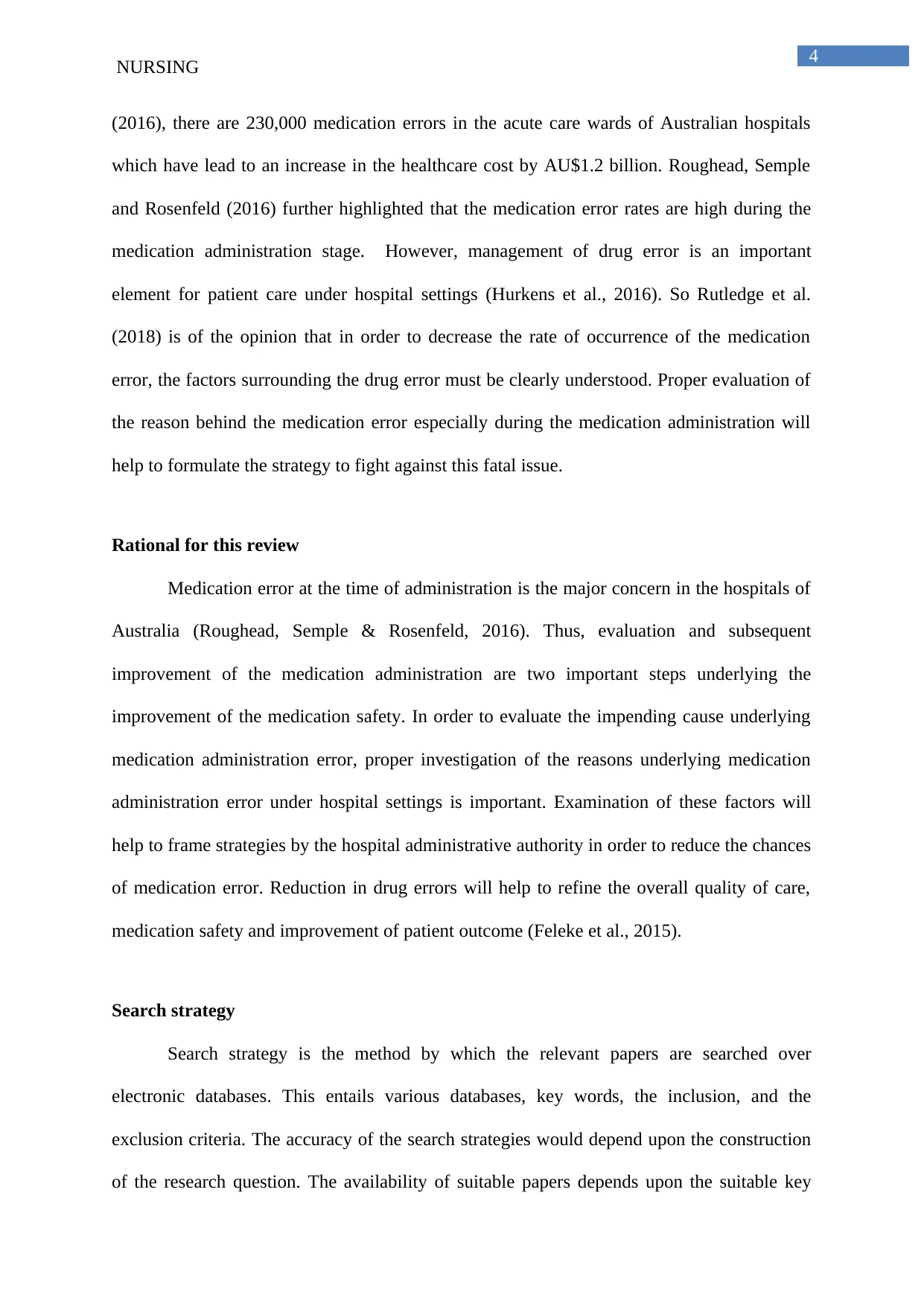
4
NURSING
(2016), there are 230,000 medication errors in the acute care wards of Australian hospitals
which have lead to an increase in the healthcare cost by AU$1.2 billion. Roughead, Semple
and Rosenfeld (2016) further highlighted that the medication error rates are high during the
medication administration stage. However, management of drug error is an important
element for patient care under hospital settings (Hurkens et al., 2016). So Rutledge et al.
(2018) is of the opinion that in order to decrease the rate of occurrence of the medication
error, the factors surrounding the drug error must be clearly understood. Proper evaluation of
the reason behind the medication error especially during the medication administration will
help to formulate the strategy to fight against this fatal issue.
Rational for this review
Medication error at the time of administration is the major concern in the hospitals of
Australia (Roughead, Semple & Rosenfeld, 2016). Thus, evaluation and subsequent
improvement of the medication administration are two important steps underlying the
improvement of the medication safety. In order to evaluate the impending cause underlying
medication administration error, proper investigation of the reasons underlying medication
administration error under hospital settings is important. Examination of these factors will
help to frame strategies by the hospital administrative authority in order to reduce the chances
of medication error. Reduction in drug errors will help to refine the overall quality of care,
medication safety and improvement of patient outcome (Feleke et al., 2015).
Search strategy
Search strategy is the method by which the relevant papers are searched over
electronic databases. This entails various databases, key words, the inclusion, and the
exclusion criteria. The accuracy of the search strategies would depend upon the construction
of the research question. The availability of suitable papers depends upon the suitable key
NURSING
(2016), there are 230,000 medication errors in the acute care wards of Australian hospitals
which have lead to an increase in the healthcare cost by AU$1.2 billion. Roughead, Semple
and Rosenfeld (2016) further highlighted that the medication error rates are high during the
medication administration stage. However, management of drug error is an important
element for patient care under hospital settings (Hurkens et al., 2016). So Rutledge et al.
(2018) is of the opinion that in order to decrease the rate of occurrence of the medication
error, the factors surrounding the drug error must be clearly understood. Proper evaluation of
the reason behind the medication error especially during the medication administration will
help to formulate the strategy to fight against this fatal issue.
Rational for this review
Medication error at the time of administration is the major concern in the hospitals of
Australia (Roughead, Semple & Rosenfeld, 2016). Thus, evaluation and subsequent
improvement of the medication administration are two important steps underlying the
improvement of the medication safety. In order to evaluate the impending cause underlying
medication administration error, proper investigation of the reasons underlying medication
administration error under hospital settings is important. Examination of these factors will
help to frame strategies by the hospital administrative authority in order to reduce the chances
of medication error. Reduction in drug errors will help to refine the overall quality of care,
medication safety and improvement of patient outcome (Feleke et al., 2015).
Search strategy
Search strategy is the method by which the relevant papers are searched over
electronic databases. This entails various databases, key words, the inclusion, and the
exclusion criteria. The accuracy of the search strategies would depend upon the construction
of the research question. The availability of suitable papers depends upon the suitable key
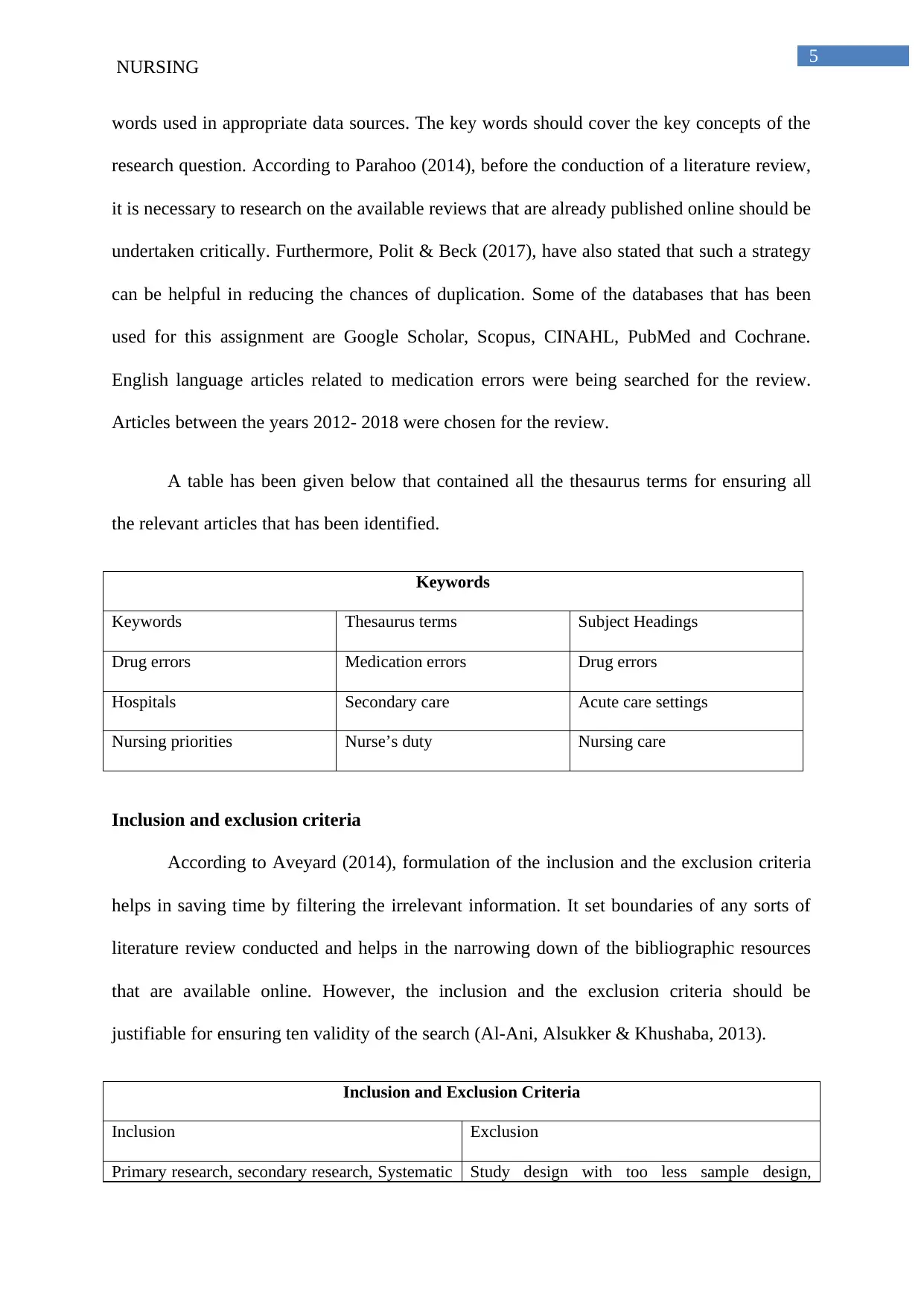
5
NURSING
words used in appropriate data sources. The key words should cover the key concepts of the
research question. According to Parahoo (2014), before the conduction of a literature review,
it is necessary to research on the available reviews that are already published online should be
undertaken critically. Furthermore, Polit & Beck (2017), have also stated that such a strategy
can be helpful in reducing the chances of duplication. Some of the databases that has been
used for this assignment are Google Scholar, Scopus, CINAHL, PubMed and Cochrane.
English language articles related to medication errors were being searched for the review.
Articles between the years 2012- 2018 were chosen for the review.
A table has been given below that contained all the thesaurus terms for ensuring all
the relevant articles that has been identified.
Keywords
Keywords Thesaurus terms Subject Headings
Drug errors Medication errors Drug errors
Hospitals Secondary care Acute care settings
Nursing priorities Nurse’s duty Nursing care
Inclusion and exclusion criteria
According to Aveyard (2014), formulation of the inclusion and the exclusion criteria
helps in saving time by filtering the irrelevant information. It set boundaries of any sorts of
literature review conducted and helps in the narrowing down of the bibliographic resources
that are available online. However, the inclusion and the exclusion criteria should be
justifiable for ensuring ten validity of the search (Al-Ani, Alsukker & Khushaba, 2013).
Inclusion and Exclusion Criteria
Inclusion Exclusion
Primary research, secondary research, Systematic Study design with too less sample design,
NURSING
words used in appropriate data sources. The key words should cover the key concepts of the
research question. According to Parahoo (2014), before the conduction of a literature review,
it is necessary to research on the available reviews that are already published online should be
undertaken critically. Furthermore, Polit & Beck (2017), have also stated that such a strategy
can be helpful in reducing the chances of duplication. Some of the databases that has been
used for this assignment are Google Scholar, Scopus, CINAHL, PubMed and Cochrane.
English language articles related to medication errors were being searched for the review.
Articles between the years 2012- 2018 were chosen for the review.
A table has been given below that contained all the thesaurus terms for ensuring all
the relevant articles that has been identified.
Keywords
Keywords Thesaurus terms Subject Headings
Drug errors Medication errors Drug errors
Hospitals Secondary care Acute care settings
Nursing priorities Nurse’s duty Nursing care
Inclusion and exclusion criteria
According to Aveyard (2014), formulation of the inclusion and the exclusion criteria
helps in saving time by filtering the irrelevant information. It set boundaries of any sorts of
literature review conducted and helps in the narrowing down of the bibliographic resources
that are available online. However, the inclusion and the exclusion criteria should be
justifiable for ensuring ten validity of the search (Al-Ani, Alsukker & Khushaba, 2013).
Inclusion and Exclusion Criteria
Inclusion Exclusion
Primary research, secondary research, Systematic Study design with too less sample design,
⊘ This is a preview!⊘
Do you want full access?
Subscribe today to unlock all pages.

Trusted by 1+ million students worldwide
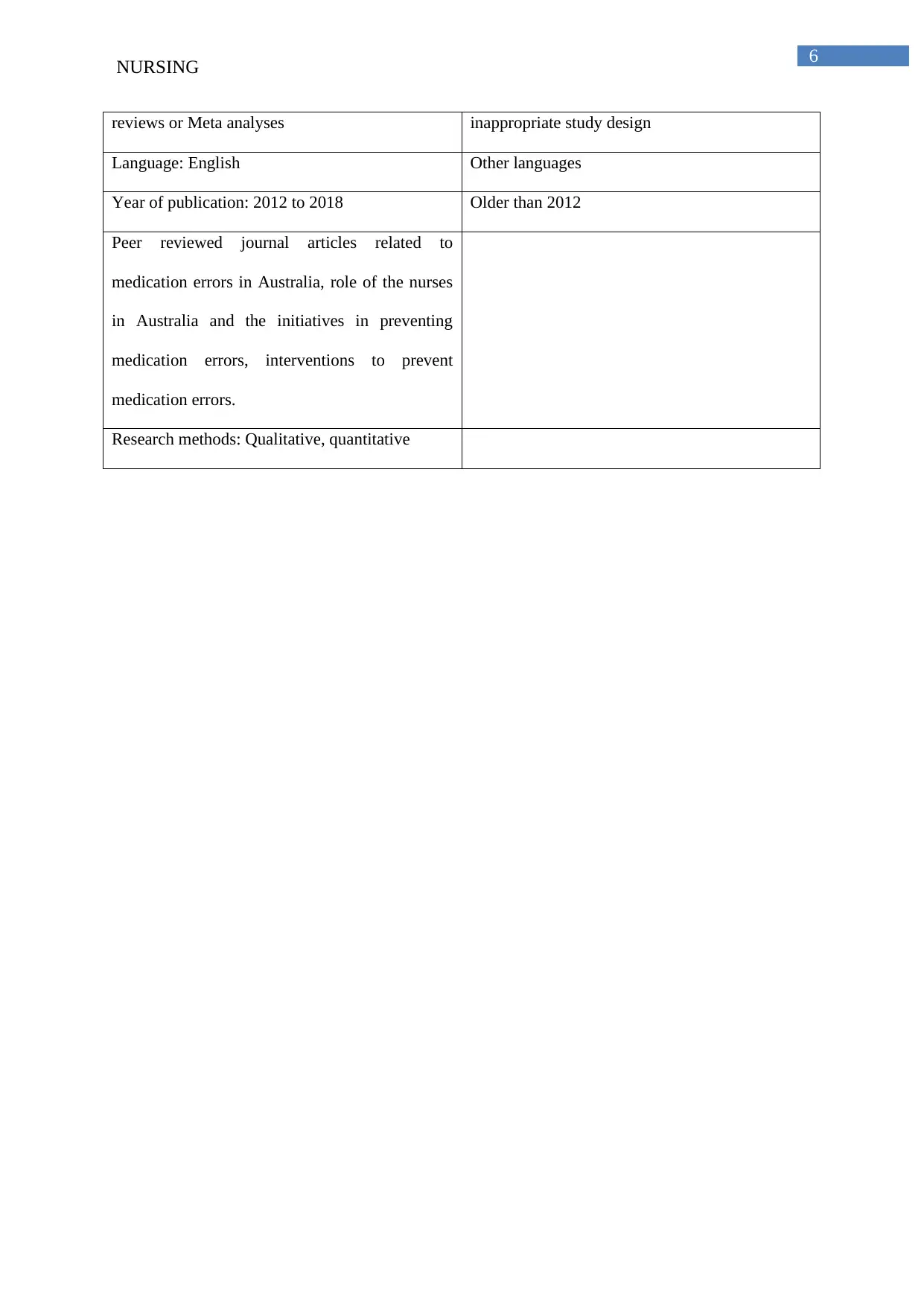
6
NURSING
reviews or Meta analyses inappropriate study design
Language: English Other languages
Year of publication: 2012 to 2018 Older than 2012
Peer reviewed journal articles related to
medication errors in Australia, role of the nurses
in Australia and the initiatives in preventing
medication errors, interventions to prevent
medication errors.
Research methods: Qualitative, quantitative
NURSING
reviews or Meta analyses inappropriate study design
Language: English Other languages
Year of publication: 2012 to 2018 Older than 2012
Peer reviewed journal articles related to
medication errors in Australia, role of the nurses
in Australia and the initiatives in preventing
medication errors, interventions to prevent
medication errors.
Research methods: Qualitative, quantitative
Paraphrase This Document
Need a fresh take? Get an instant paraphrase of this document with our AI Paraphraser
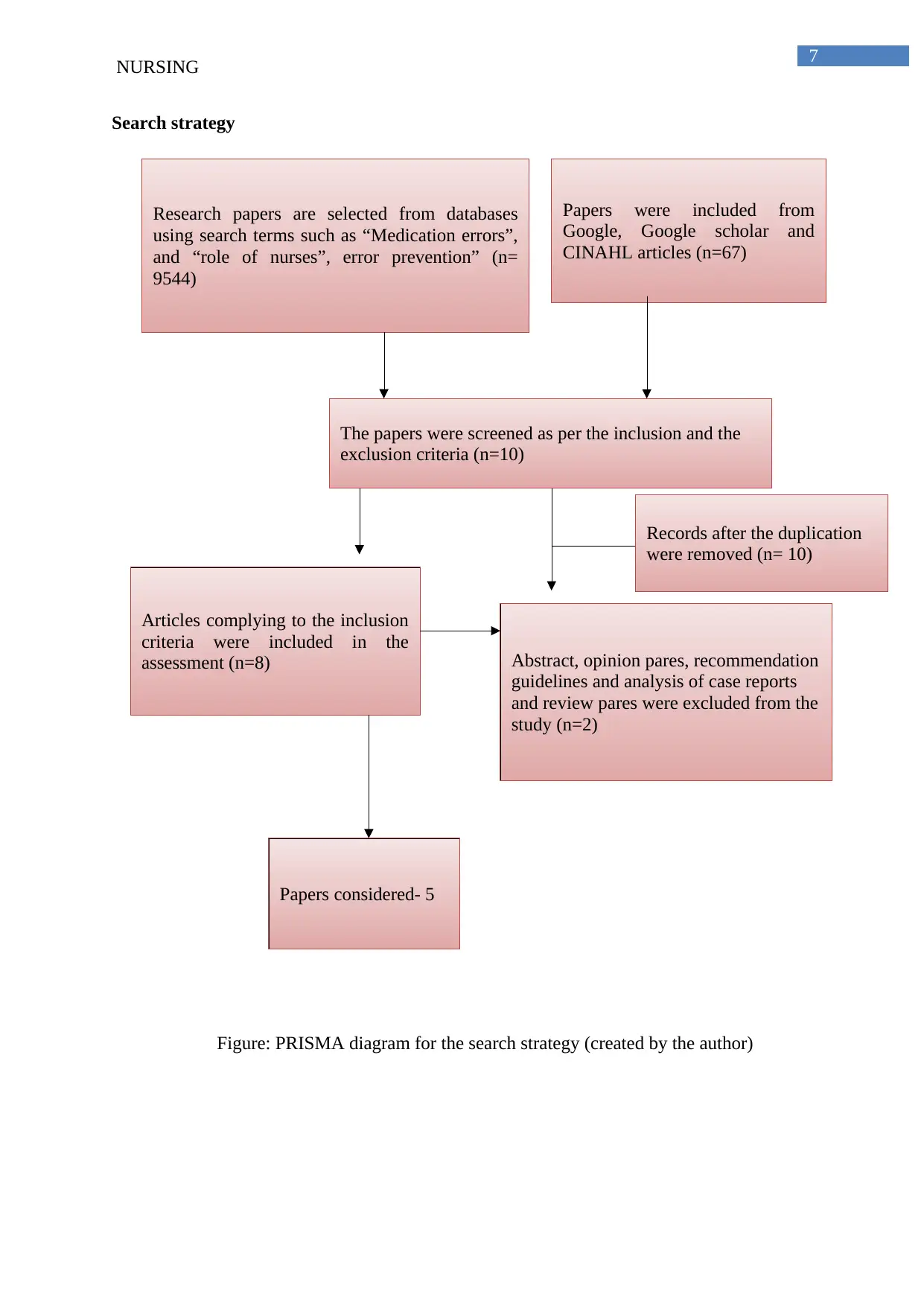
7
Research papers are selected from databases
using search terms such as “Medication errors”,
and “role of nurses”, error prevention” (n=
9544)
Papers were included from
Google, Google scholar and
CINAHL articles (n=67)
The papers were screened as per the inclusion and the
exclusion criteria (n=10)
Articles complying to the inclusion
criteria were included in the
assessment (n=8) Abstract, opinion pares, recommendation
guidelines and analysis of case reports
and review pares were excluded from the
study (n=2)
Records after the duplication
were removed (n= 10)
Papers considered- 5
Figure: PRISMA diagram for the search strategy (created by the author)
NURSING
Search strategy
Research papers are selected from databases
using search terms such as “Medication errors”,
and “role of nurses”, error prevention” (n=
9544)
Papers were included from
Google, Google scholar and
CINAHL articles (n=67)
The papers were screened as per the inclusion and the
exclusion criteria (n=10)
Articles complying to the inclusion
criteria were included in the
assessment (n=8) Abstract, opinion pares, recommendation
guidelines and analysis of case reports
and review pares were excluded from the
study (n=2)
Records after the duplication
were removed (n= 10)
Papers considered- 5
Figure: PRISMA diagram for the search strategy (created by the author)
NURSING
Search strategy
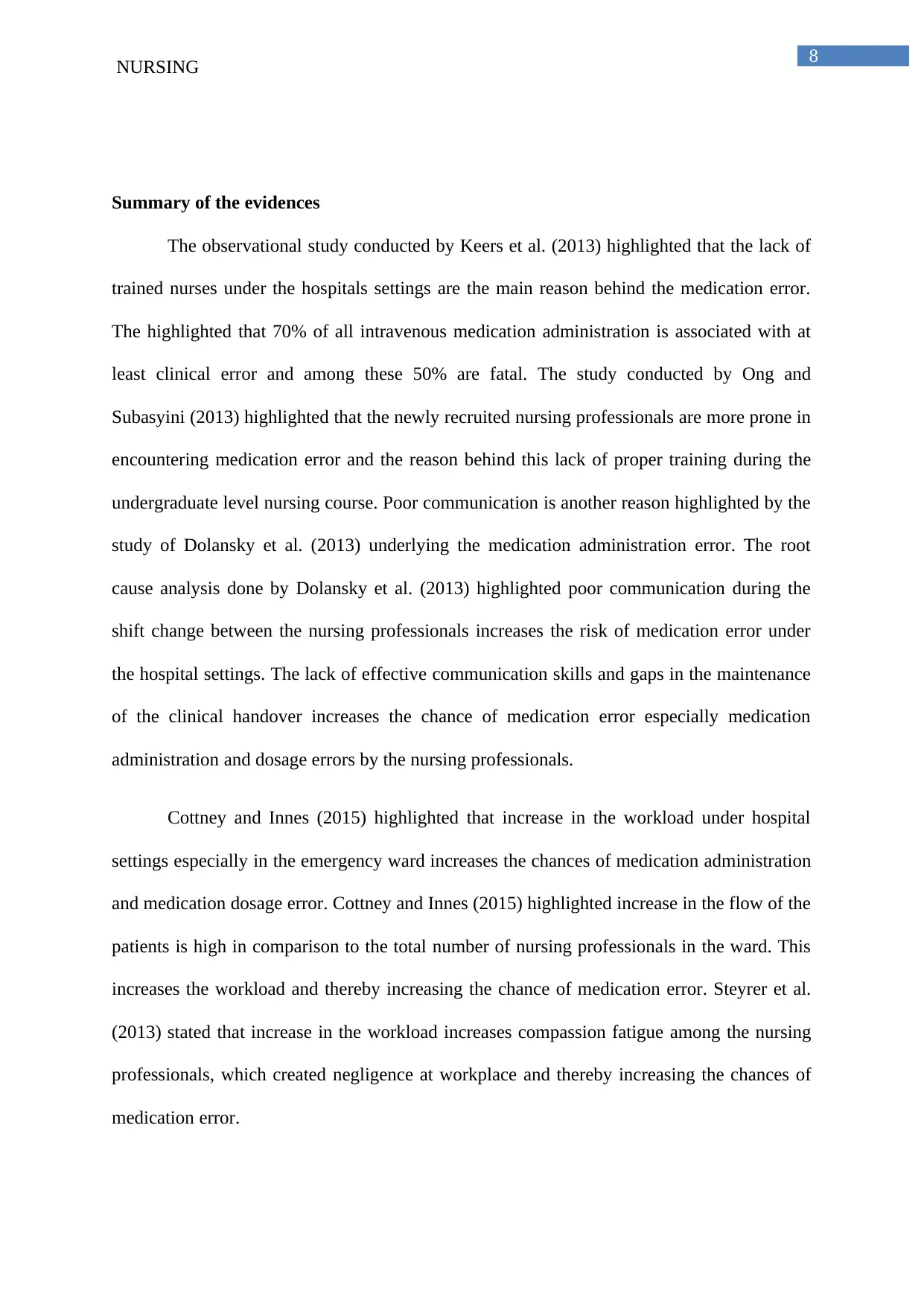
8
NURSING
Summary of the evidences
The observational study conducted by Keers et al. (2013) highlighted that the lack of
trained nurses under the hospitals settings are the main reason behind the medication error.
The highlighted that 70% of all intravenous medication administration is associated with at
least clinical error and among these 50% are fatal. The study conducted by Ong and
Subasyini (2013) highlighted that the newly recruited nursing professionals are more prone in
encountering medication error and the reason behind this lack of proper training during the
undergraduate level nursing course. Poor communication is another reason highlighted by the
study of Dolansky et al. (2013) underlying the medication administration error. The root
cause analysis done by Dolansky et al. (2013) highlighted poor communication during the
shift change between the nursing professionals increases the risk of medication error under
the hospital settings. The lack of effective communication skills and gaps in the maintenance
of the clinical handover increases the chance of medication error especially medication
administration and dosage errors by the nursing professionals.
Cottney and Innes (2015) highlighted that increase in the workload under hospital
settings especially in the emergency ward increases the chances of medication administration
and medication dosage error. Cottney and Innes (2015) highlighted increase in the flow of the
patients is high in comparison to the total number of nursing professionals in the ward. This
increases the workload and thereby increasing the chance of medication error. Steyrer et al.
(2013) stated that increase in the workload increases compassion fatigue among the nursing
professionals, which created negligence at workplace and thereby increasing the chances of
medication error.
NURSING
Summary of the evidences
The observational study conducted by Keers et al. (2013) highlighted that the lack of
trained nurses under the hospitals settings are the main reason behind the medication error.
The highlighted that 70% of all intravenous medication administration is associated with at
least clinical error and among these 50% are fatal. The study conducted by Ong and
Subasyini (2013) highlighted that the newly recruited nursing professionals are more prone in
encountering medication error and the reason behind this lack of proper training during the
undergraduate level nursing course. Poor communication is another reason highlighted by the
study of Dolansky et al. (2013) underlying the medication administration error. The root
cause analysis done by Dolansky et al. (2013) highlighted poor communication during the
shift change between the nursing professionals increases the risk of medication error under
the hospital settings. The lack of effective communication skills and gaps in the maintenance
of the clinical handover increases the chance of medication error especially medication
administration and dosage errors by the nursing professionals.
Cottney and Innes (2015) highlighted that increase in the workload under hospital
settings especially in the emergency ward increases the chances of medication administration
and medication dosage error. Cottney and Innes (2015) highlighted increase in the flow of the
patients is high in comparison to the total number of nursing professionals in the ward. This
increases the workload and thereby increasing the chance of medication error. Steyrer et al.
(2013) stated that increase in the workload increases compassion fatigue among the nursing
professionals, which created negligence at workplace and thereby increasing the chances of
medication error.
⊘ This is a preview!⊘
Do you want full access?
Subscribe today to unlock all pages.

Trusted by 1+ million students worldwide
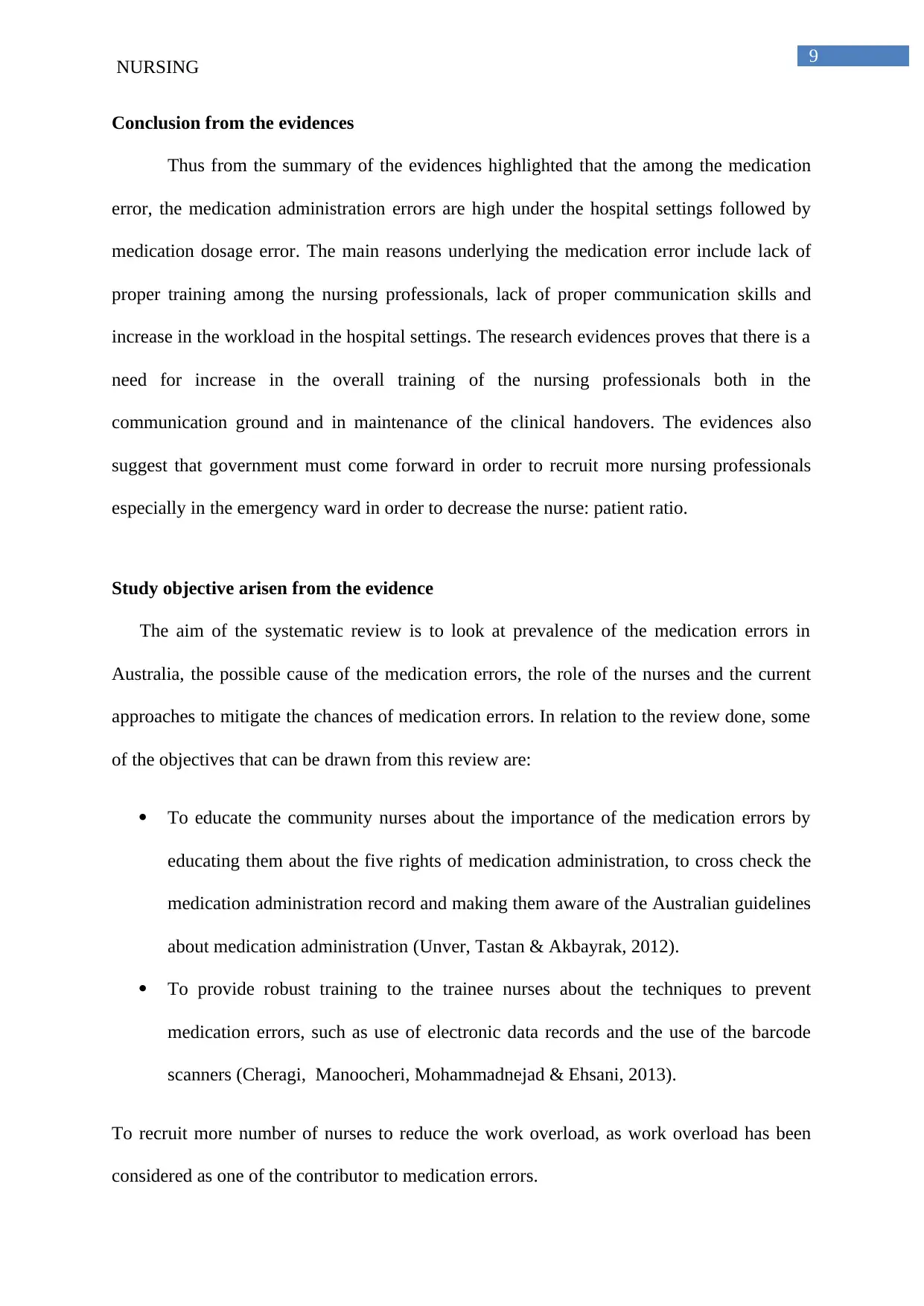
9
NURSING
Conclusion from the evidences
Thus from the summary of the evidences highlighted that the among the medication
error, the medication administration errors are high under the hospital settings followed by
medication dosage error. The main reasons underlying the medication error include lack of
proper training among the nursing professionals, lack of proper communication skills and
increase in the workload in the hospital settings. The research evidences proves that there is a
need for increase in the overall training of the nursing professionals both in the
communication ground and in maintenance of the clinical handovers. The evidences also
suggest that government must come forward in order to recruit more nursing professionals
especially in the emergency ward in order to decrease the nurse: patient ratio.
Study objective arisen from the evidence
The aim of the systematic review is to look at prevalence of the medication errors in
Australia, the possible cause of the medication errors, the role of the nurses and the current
approaches to mitigate the chances of medication errors. In relation to the review done, some
of the objectives that can be drawn from this review are:
To educate the community nurses about the importance of the medication errors by
educating them about the five rights of medication administration, to cross check the
medication administration record and making them aware of the Australian guidelines
about medication administration (Unver, Tastan & Akbayrak, 2012).
To provide robust training to the trainee nurses about the techniques to prevent
medication errors, such as use of electronic data records and the use of the barcode
scanners (Cheragi, Manoocheri, Mohammadnejad & Ehsani, 2013).
To recruit more number of nurses to reduce the work overload, as work overload has been
considered as one of the contributor to medication errors.
NURSING
Conclusion from the evidences
Thus from the summary of the evidences highlighted that the among the medication
error, the medication administration errors are high under the hospital settings followed by
medication dosage error. The main reasons underlying the medication error include lack of
proper training among the nursing professionals, lack of proper communication skills and
increase in the workload in the hospital settings. The research evidences proves that there is a
need for increase in the overall training of the nursing professionals both in the
communication ground and in maintenance of the clinical handovers. The evidences also
suggest that government must come forward in order to recruit more nursing professionals
especially in the emergency ward in order to decrease the nurse: patient ratio.
Study objective arisen from the evidence
The aim of the systematic review is to look at prevalence of the medication errors in
Australia, the possible cause of the medication errors, the role of the nurses and the current
approaches to mitigate the chances of medication errors. In relation to the review done, some
of the objectives that can be drawn from this review are:
To educate the community nurses about the importance of the medication errors by
educating them about the five rights of medication administration, to cross check the
medication administration record and making them aware of the Australian guidelines
about medication administration (Unver, Tastan & Akbayrak, 2012).
To provide robust training to the trainee nurses about the techniques to prevent
medication errors, such as use of electronic data records and the use of the barcode
scanners (Cheragi, Manoocheri, Mohammadnejad & Ehsani, 2013).
To recruit more number of nurses to reduce the work overload, as work overload has been
considered as one of the contributor to medication errors.
Paraphrase This Document
Need a fresh take? Get an instant paraphrase of this document with our AI Paraphraser

10
NURSING
References
Al-Ani, A., Alsukker, A., &Khushaba, R. N. (2013). Feature subset selection using
differential evolution and a wheel based search strategy. Swarm and Evolutionary
Computation, 9, 15-26. https://doi.org/10.1016/j.swevo.2012.09.003
Ashcroft, D. M., Lewis, P. J., Tully, M. P., Farragher, T. M., Taylor, D., Wass, V., ... &
Dornan, T. (2015). Prevalence, nature, severity and risk factors for prescribing errors
in hospital inpatients: prospective study in 20 UK hospitals. Drug safety, 38(9), 833-
843. https://doi.org/10.1007/s40264-015-0320-x
Aveyard, H., (2014). Doing a literature review in health and social care: A practical guide.
McGraw-Hill Education (UK). Retrieved from: https://books.google.co.in/books?
hl=en&lr=&id=qYdFBgAAQBAJ&oi=fnd&pg=PP1&dq=Aveyard,+H.,+(2014).
+Doing+a+literature+review+in+health+and+social+care:+A+practical+guide.
+McGraw-Hill+Education+(UK).&ots=aQ5-6JHci3&sig=CBs_F40OhkCxWoKFF-
c6wzpCTgc#v=onepage&q=Aveyard%2C%20H.%2C%20(2014).%20Doing%20a
%20literature%20review%20in%20health%20and%20social%20care%3A%20A
%20practical%20guide.%20McGraw-Hill%20Education%20(UK).&f=false
Berdot, S., Sabatier, B., Gillaizeau, F., Caruba, T., Prognon, P., & Durieux, P. (2012).
Evaluation of drug administration errors in a teaching hospital. BMC health services
research, 12(1), 60. https://doi.org/10.1186/1472-6963-12-60
Cheragi, M. A., Manoocheri, H., Mohammadnejad, E., &Ehsani, S. R. (2013). Types and
causes of medication errors from nurse's viewpoint. Iranian journal of nursing and
midwifery research, 18(3), 228.
https://www.ncbi.nlm.nih.gov/pmc/articles/PMC3748543/
NURSING
References
Al-Ani, A., Alsukker, A., &Khushaba, R. N. (2013). Feature subset selection using
differential evolution and a wheel based search strategy. Swarm and Evolutionary
Computation, 9, 15-26. https://doi.org/10.1016/j.swevo.2012.09.003
Ashcroft, D. M., Lewis, P. J., Tully, M. P., Farragher, T. M., Taylor, D., Wass, V., ... &
Dornan, T. (2015). Prevalence, nature, severity and risk factors for prescribing errors
in hospital inpatients: prospective study in 20 UK hospitals. Drug safety, 38(9), 833-
843. https://doi.org/10.1007/s40264-015-0320-x
Aveyard, H., (2014). Doing a literature review in health and social care: A practical guide.
McGraw-Hill Education (UK). Retrieved from: https://books.google.co.in/books?
hl=en&lr=&id=qYdFBgAAQBAJ&oi=fnd&pg=PP1&dq=Aveyard,+H.,+(2014).
+Doing+a+literature+review+in+health+and+social+care:+A+practical+guide.
+McGraw-Hill+Education+(UK).&ots=aQ5-6JHci3&sig=CBs_F40OhkCxWoKFF-
c6wzpCTgc#v=onepage&q=Aveyard%2C%20H.%2C%20(2014).%20Doing%20a
%20literature%20review%20in%20health%20and%20social%20care%3A%20A
%20practical%20guide.%20McGraw-Hill%20Education%20(UK).&f=false
Berdot, S., Sabatier, B., Gillaizeau, F., Caruba, T., Prognon, P., & Durieux, P. (2012).
Evaluation of drug administration errors in a teaching hospital. BMC health services
research, 12(1), 60. https://doi.org/10.1186/1472-6963-12-60
Cheragi, M. A., Manoocheri, H., Mohammadnejad, E., &Ehsani, S. R. (2013). Types and
causes of medication errors from nurse's viewpoint. Iranian journal of nursing and
midwifery research, 18(3), 228.
https://www.ncbi.nlm.nih.gov/pmc/articles/PMC3748543/
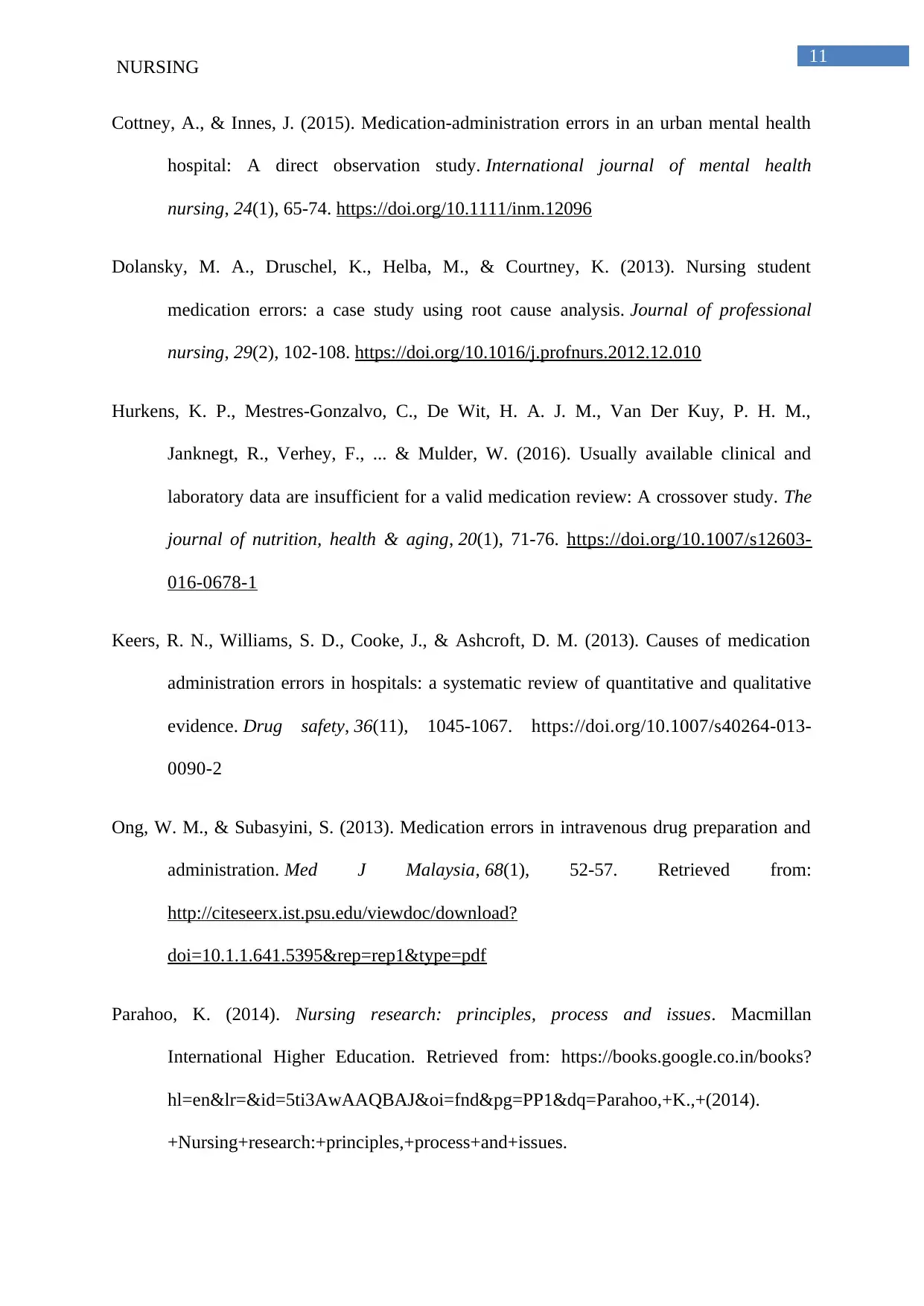
11
NURSING
Cottney, A., & Innes, J. (2015). Medication‐administration errors in an urban mental health
hospital: A direct observation study. International journal of mental health
nursing, 24(1), 65-74. https://doi.org/10.1111/inm.12096
Dolansky, M. A., Druschel, K., Helba, M., & Courtney, K. (2013). Nursing student
medication errors: a case study using root cause analysis. Journal of professional
nursing, 29(2), 102-108. https://doi.org/10.1016/j.profnurs.2012.12.010
Hurkens, K. P., Mestres-Gonzalvo, C., De Wit, H. A. J. M., Van Der Kuy, P. H. M.,
Janknegt, R., Verhey, F., ... & Mulder, W. (2016). Usually available clinical and
laboratory data are insufficient for a valid medication review: A crossover study. The
journal of nutrition, health & aging, 20(1), 71-76. https://doi.org/10.1007/s12603-
016-0678-1
Keers, R. N., Williams, S. D., Cooke, J., & Ashcroft, D. M. (2013). Causes of medication
administration errors in hospitals: a systematic review of quantitative and qualitative
evidence. Drug safety, 36(11), 1045-1067. https://doi.org/10.1007/s40264-013-
0090-2
Ong, W. M., & Subasyini, S. (2013). Medication errors in intravenous drug preparation and
administration. Med J Malaysia, 68(1), 52-57. Retrieved from:
http://citeseerx.ist.psu.edu/viewdoc/download?
doi=10.1.1.641.5395&rep=rep1&type=pdf
Parahoo, K. (2014). Nursing research: principles, process and issues. Macmillan
International Higher Education. Retrieved from: https://books.google.co.in/books?
hl=en&lr=&id=5ti3AwAAQBAJ&oi=fnd&pg=PP1&dq=Parahoo,+K.,+(2014).
+Nursing+research:+principles,+process+and+issues.
NURSING
Cottney, A., & Innes, J. (2015). Medication‐administration errors in an urban mental health
hospital: A direct observation study. International journal of mental health
nursing, 24(1), 65-74. https://doi.org/10.1111/inm.12096
Dolansky, M. A., Druschel, K., Helba, M., & Courtney, K. (2013). Nursing student
medication errors: a case study using root cause analysis. Journal of professional
nursing, 29(2), 102-108. https://doi.org/10.1016/j.profnurs.2012.12.010
Hurkens, K. P., Mestres-Gonzalvo, C., De Wit, H. A. J. M., Van Der Kuy, P. H. M.,
Janknegt, R., Verhey, F., ... & Mulder, W. (2016). Usually available clinical and
laboratory data are insufficient for a valid medication review: A crossover study. The
journal of nutrition, health & aging, 20(1), 71-76. https://doi.org/10.1007/s12603-
016-0678-1
Keers, R. N., Williams, S. D., Cooke, J., & Ashcroft, D. M. (2013). Causes of medication
administration errors in hospitals: a systematic review of quantitative and qualitative
evidence. Drug safety, 36(11), 1045-1067. https://doi.org/10.1007/s40264-013-
0090-2
Ong, W. M., & Subasyini, S. (2013). Medication errors in intravenous drug preparation and
administration. Med J Malaysia, 68(1), 52-57. Retrieved from:
http://citeseerx.ist.psu.edu/viewdoc/download?
doi=10.1.1.641.5395&rep=rep1&type=pdf
Parahoo, K. (2014). Nursing research: principles, process and issues. Macmillan
International Higher Education. Retrieved from: https://books.google.co.in/books?
hl=en&lr=&id=5ti3AwAAQBAJ&oi=fnd&pg=PP1&dq=Parahoo,+K.,+(2014).
+Nursing+research:+principles,+process+and+issues.
⊘ This is a preview!⊘
Do you want full access?
Subscribe today to unlock all pages.

Trusted by 1+ million students worldwide
1 out of 13
Related Documents
Your All-in-One AI-Powered Toolkit for Academic Success.
+13062052269
info@desklib.com
Available 24*7 on WhatsApp / Email
![[object Object]](/_next/static/media/star-bottom.7253800d.svg)
Unlock your academic potential
Copyright © 2020–2025 A2Z Services. All Rights Reserved. Developed and managed by ZUCOL.





